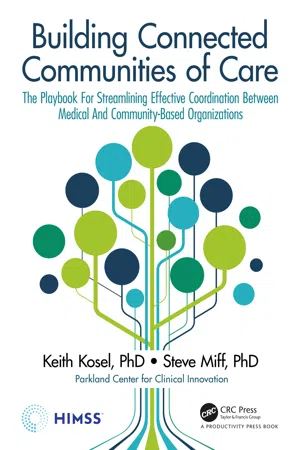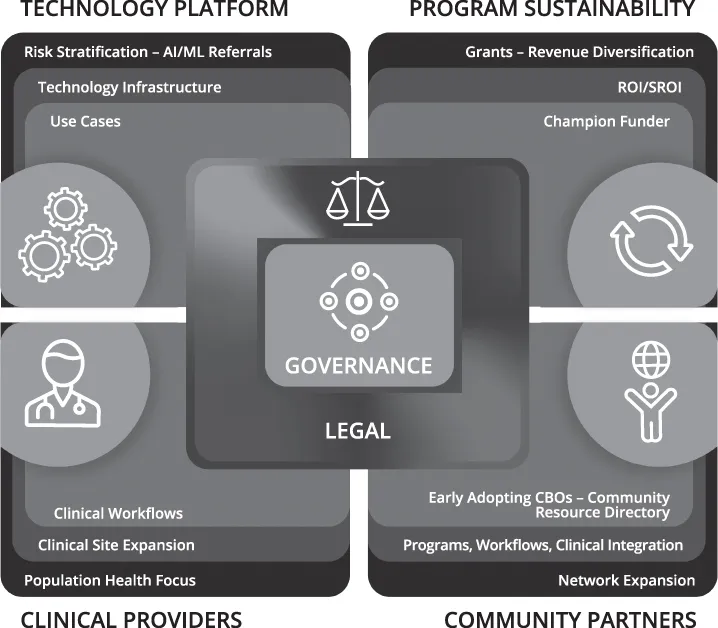
Building Connected Communities of Care
The Playbook For Streamlining Effective Coordination Between Medical And Community-Based Organizations
- 286 pages
- English
- ePUB (mobile friendly)
- Available on iOS & Android
Building Connected Communities of Care
The Playbook For Streamlining Effective Coordination Between Medical And Community-Based Organizations
About this book
As a community, aligning efforts across a community to support the safety and well-being of vulnerable and underserved individuals is extraordinarily difficult. These individuals suffer disproportionally from health issues, job loss, a lack of stable housing, high utility costs, substance abuse, and homelessness. In addition to medical care, these individuals often critically need access to community social sector organizations that provide a distinct and complementary set of services, such as housing, food services, emergency utility assistance, and employment assistance. These services are just as vital as healthcare services to these individuals' long-term health and well-being, with data suggesting that 80–90% of health outcomes can be attributed to factors beyond direct medical intervention.
This book proposes a novel approach to the coordination of medicine and social services through the use of people, process, and technology, with the goal being to streamline coordination between medical and Community-Based Organizations and to promote true cross-sector patient and client advocacy. The book is based on the experience of Dallas, TX, which was one of the first metropolitan regions to develop a comprehensive foundation for partnership between a community's clinical and social sectors using web-based information exchange. In the 5 years since the initial launch, the authors have been able to provide seamless connection, communication, and coordination between healthcare providers and a wide array of community-based social service organizations (a/k/a Community-Based Organizations or CBOs), criminal justice entities, and various other community organizations, including non-collegiate educational systems.
This practical how-to guide is the codification of transferrable lessons from successes and challenges faced when working with clinical, community, and government leaders. By reading this playbook, leaders interested in building (or expanding) connected clinical-community services will learn how to: 1) facilitate cross-sector care coordination; 2) enable community care partners to better provide targeted services to community residents; 3) reduce duplication of services across partnering organizations; and 4) help to bridge service gaps in the currently fragmented system. Implementation of services, as recommended in this book, will ultimately streamline assistance efforts, reduce repeat crises and emergency funding requests, help address disparities of care, and improve the health, safety, and well-being of the most vulnerable community residents.
Frequently asked questions
- Essential is ideal for learners and professionals who enjoy exploring a wide range of subjects. Access the Essential Library with 800,000+ trusted titles and best-sellers across business, personal growth, and the humanities. Includes unlimited reading time and Standard Read Aloud voice.
- Complete: Perfect for advanced learners and researchers needing full, unrestricted access. Unlock 1.4M+ books across hundreds of subjects, including academic and specialized titles. The Complete Plan also includes advanced features like Premium Read Aloud and Research Assistant.
Please note we cannot support devices running on iOS 13 and Android 7 or earlier. Learn more about using the app.
Information
Chapter 1
Playbook Overview
Playbook Purpose
- Detailed description of the six core Tracks orchestrating
CCC design and implementation - Key roles and responsibilities
- Requirements (and associated Milestones) to successfully complete each Track
- Strategies for success and overcoming challenges
- Case studies and practice pointers highlighting
PCCI lessons learned - Workflows/processes
CCC measurements of success - Key sample documents for successful
CCC design and implementation
Guide to Playbook Terminology
- “Track” is a primary pathway supporting a
CCC’s design, implementation, and ongoing operations. - “Requirement” is an essential element that should be completed within each Track. Although the Requirements are numbered sequentially, based on
PCCI’s experience, the actual timing of the work across Requirements may vary or occur in parallel with work in other Requirements or even work across other Tracks. - “Milestone” is a waypost measuring the progress of the work conducted in a specific Requirement towards the ultimate goal. Although the Milestones are numbered sequentially based on the typical progress towards goal attainment, it is possible that certain Milestones may be completed in parallel with other Milestones within a Requirement or even across Requirements.
- “Practice Pointer” is a
PCCI example strategy in overcoming challenges to successful CCC implementation. - “Key Task” is an essential activity (in no specific sequential order) to be performed in achieving Milestones.
The Six Tracks for CCC Implementation

- Governance Track. A
CCC’s governance structure relies on a collective decision-making model rather than on leadership by a specific individual or organization. This Playbook assumes that a few key community organizations have already formed an initial steering group to make the significant decision to undertake the CCC initiative. It is critical, at least initially, for an empowered, established group of decision makers to provide leadership through a “readiness assessment” process and during the initial CCC design stages. The “readiness assessment” comprises a set of activities designed to collectively uncover a community’s clinical and social needs and level of preparedness and commitment to hosting a CCC. See Chapter 2 The Readiness Assessment. These key decision makers should initially include Anchors, Partners, Sponsors, or Funders (defined in the “CCC Roles and Responsibilities” section). As the CCC evolves, the governance entity can (and should) expand to include the perspectives of a wider group of community participants. Formal establishment of a governance entity (e.g., a Board) can take place at any point in the process but likely oc...
Table of contents
- Cover
- Half Title
- Title Page
- Copyright Page
- Contents
- The Call to Action
- Foreword
- Preface
- Contributors
- About the Authors
- List of Commonly Used Abbreviations
- 1 Playbook Overview
- 2 The Readiness Assessment
- 3 Governance Track
- 4 Legal/Policy Track
- 5 Technology Platform Track
- 6 Clinical Providers Track
- 7 Community Partners Track
- 8 Program Sustainability Track
- 9 Final Notes
- Key Documents
- References
- Index